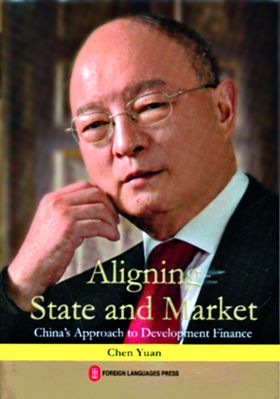China's approach to development finance
- Byt Zhou Lin
 0 Comment(s)
0 Comment(s) Print
Print E-mail China Today, February 6, 2017
E-mail China Today, February 6, 2017
 |
|
Aligning State and Market Author: Chen Yuan |
Aligning State and Market: China's Approach to Development Finance is authored by economist Chen Yuan – former president of the China Development Bank. The book records how Chen Yuan and China Development Bank (CDB) gave full play to the theory of development finance to solve problems regarding people's livelihoods and national development.
For the first time, Chen Yuan reveals the formulation process of major investment policies from his own perspective, together with an in-depth analysis of both national circumstances and the international situation. All these occurrences epitomize China's socio-economic development, especially in the financial area, in recent decades, thus making it a must-read to understand the "government and market" with Chinese characteristics.
Chen Yuan has made remarkable achievements in economic and financial theories. During his 20-plus years of financial work experience, whether as a supervisor or a practitioner, he has insisted on financial reforms. Since the Asian economic crisis in 1998, Chen Yuan has led the CDB's change from a traditional policy bank to a world-class development financing institute, with increasing global impact – all thanks to his development finance theory.
What is development finance? It is essentially a financial method that serves the national development strategy through medium- and long-term investment and financing. Based on both the government's credibility and market rules, it breaks through the bottleneck of social and economic development, safeguards financial stability and strengthens competitiveness. Whether in a developing or developed country, where there is a development deadlock there is leeway for development finance to show its capabilities. Otherwise, neither the market itself nor business financing can achieve the government's development goals.
The whole book – which includes a discussion on the practical exploration of development finance – covers topics ranging from bank-government partnership and national strategy to regional planning and international financial cooperation. Each chapter constitutes three parts: a case study, theory, and practice, in which the author presents both background information and big events, together with his publications and interviews with the media.
In 1998, due to the disastrous Asian financial crisis, China's economy suffered an enormous shock. The Chinese government formulated a series of policies to accelerate infrastructure construction, major project construction, enterprises' technological upgrading and as encouragement to invest in fixed assets. CDB was then the largest policy bank in China and shouldered the responsibility of discovering new sources of economic growth. Chen Yuan immediately carried out investigations in eight provinces and municipalities that summer, and built a new-type of bank-government partnership – the Wuhu Model – with local government. Its aim was to construct a new financing platform and to highlight urban infrastructure in accelerating economic growth.
In 2000, the State Council promulgated the Western Development Strategy. CDB strengthened cooperation with local governments to speed up the establishment of a market mechanism and scientific planning in western areas. It also helped with financing to bolster local infrastructure buildings and the development of characteristic industries. During the decade from 2001 to 2010, CDB issued accumulated loans of RMB 1.66 trillion to 12 western provinces, autonomous regions and municipalities, accounting for one fourth of CDB's total loans over the same period.
Inclusive finance is another area CDB mainly focuses on. The bank creatively transformed long-standing problems concerning people's livelihoods, such as student loans, government-subsidized housing projects, the three rural issues of agriculture, farmers and rural areas, medium-sized and small enterprises, and water conservancy construction, into sustainable major bank businesses. CDB is the bank that gives the largest loans to poor students and for affordable housing projects. It is also a major force in supporting new construction in rural areas, water conservancy construction and medium-sized and small enterprises development.
In 2008, the global economic crisis, triggered by the sub-prime crisis, shocked the world. China's central authority readjusted its macro-economic policies. In November, the State Council promulgated 10 measures to expand domestic demand and accelerate steady and rapid economic growth. Among them, government-subsidized housing projects, rural infrastructure construction, and construction of railway, highways, and airports were the priority of CDB. More than a month before the end of 2008, CDB had finished the assignment of the Central Bank of China with an increase of RMB 70.2 billion credit availability, thus bolstering China's economic stabilization and recovery.
How can one find the joint point of government credit and market credit? More and more governments have realized that giving full play to development finance is an effective way to handle the global financial crisis. Development financing institutes in various countries have expanded their strong support for economic entities and made contributions to safeguarding market stability and reviving national economies.






Go to Forum >>0 Comment(s)